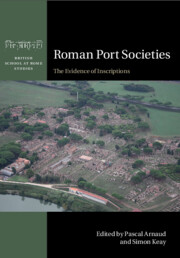Book contents
- Roman Port Societies
- British School at Rome Studies
- Roman Port Societies
- Copyright page
- Contents
- Figures
- Tables
- Contributors
- Abbreviations
- 1 The Context of Roman Mediterranean Port Societies
- 2 Inscriptions and Port Societies
- 3 Stationes and Associations of Merchants at Puteoli and Delos
- 4 Boatmen and their Corpora in the Great Ports of the Roman West (Second to Third Centuries AD)
- 5 Roman Port Societies and Their Collegia
- 6 Port Occupations and Social Hierarchies
- 7 Warehouse Societies
- 8 The Imperial Cult and the Sacred Bonds of Roman Overseas Commerce
- 9 Law and Life in Roman Harbours
- 10 Living Like a Cosmopolitan?
- 11 Ports, Trade and Supply Routes in Western Europe
- 12 The Port Society of Narona
- 13 Municipal Authority, Central Authority and Euergetists at Work at the Port
- 14 The Structure of Mercantile Communities in the Roman World
- 15 Polysemy, Epigraphic Habit and Social Legibility of Maritime Shippers
- 16 Reading Roman Port Societies
- Indexes
- References
5 - Roman Port Societies and TheirCollegia
Differences and Similarities between theAssociations of Ostia and Ephesos
Published online by Cambridge University Press: 30 October 2020
- Roman Port Societies
- British School at Rome Studies
- Roman Port Societies
- Copyright page
- Contents
- Figures
- Tables
- Contributors
- Abbreviations
- 1 The Context of Roman Mediterranean Port Societies
- 2 Inscriptions and Port Societies
- 3 Stationes and Associations of Merchants at Puteoli and Delos
- 4 Boatmen and their Corpora in the Great Ports of the Roman West (Second to Third Centuries AD)
- 5 Roman Port Societies and Their Collegia
- 6 Port Occupations and Social Hierarchies
- 7 Warehouse Societies
- 8 The Imperial Cult and the Sacred Bonds of Roman Overseas Commerce
- 9 Law and Life in Roman Harbours
- 10 Living Like a Cosmopolitan?
- 11 Ports, Trade and Supply Routes in Western Europe
- 12 The Port Society of Narona
- 13 Municipal Authority, Central Authority and Euergetists at Work at the Port
- 14 The Structure of Mercantile Communities in the Roman World
- 15 Polysemy, Epigraphic Habit and Social Legibility of Maritime Shippers
- 16 Reading Roman Port Societies
- Indexes
- References
Summary
Recent years have witnessed a growing scholarlyinterest in ancient seaports, which consequentlyhave become a research category of their own. Portcities are seen as a specific class of city: in ageographical perspective, ancient cities weretopographically and administratively self-containedsettlements with large populations which were basedupon specialization, division of labour and socialdifferentiation. The city functioned therefore as acentral focus for its surroundings in economic butalso in political, administrative, religious andcultural terms. These different functions led to amanifoldness of the urban fabric. Port cities areadditionally characterized by their geographicalposition at the waterfront and by the spatial andeconomic symbiosis between port and city. Becauseships provided the most convenient means oftransport, port cities served as communication nodesbetween terrestrial and maritime networks, and werethus the focus of supra-regional trade linksconnecting the local with the global. Beingdestinations for immigrants, they became religiousmelting pots with growing populations who demandedcommodities, foodstuffs and services. In view ofthis, it has been assumed that port societies sharedsimilar religious, social and economic structures.It is further argued that port cities weresufficiently distinctive to form a specific urbantype, with the implicit assumption that they wereall shaped by identical developments and settings.The aim of this chapter is to scrutinize thisunderlying assumption of uniformity by focusing on asocially, religiously and economically importantphenomenon of Roman port societies, the collegia, and their socialintegration.
- Type
- Chapter
- Information
- Roman Port SocietiesThe Evidence of Inscriptions, pp. 107 - 131Publisher: Cambridge University PressPrint publication year: 2020

